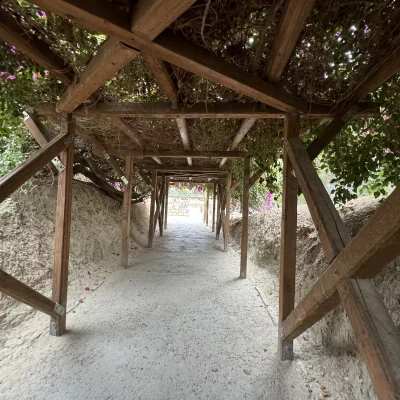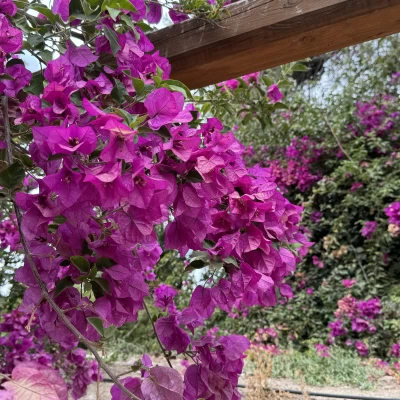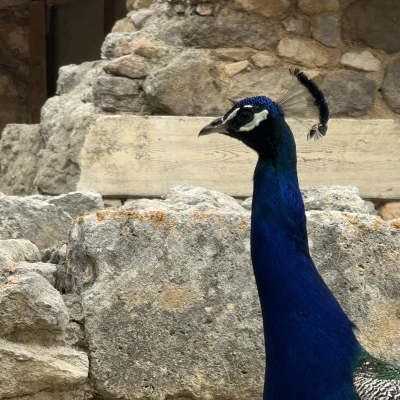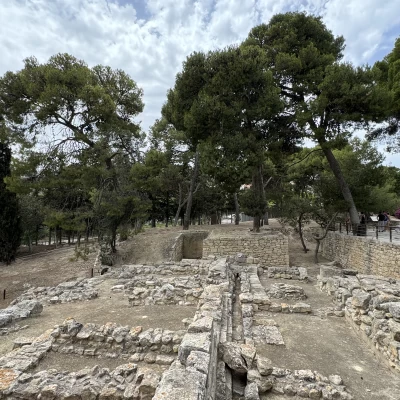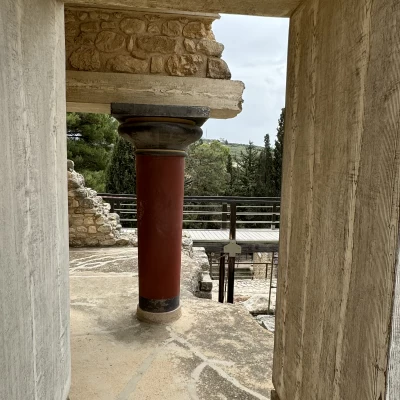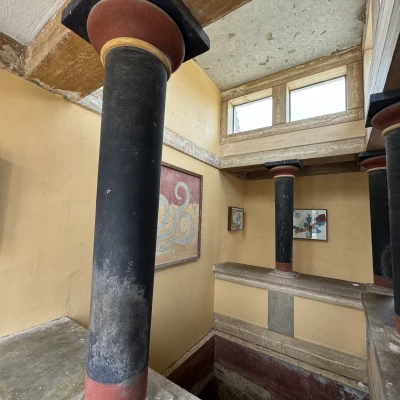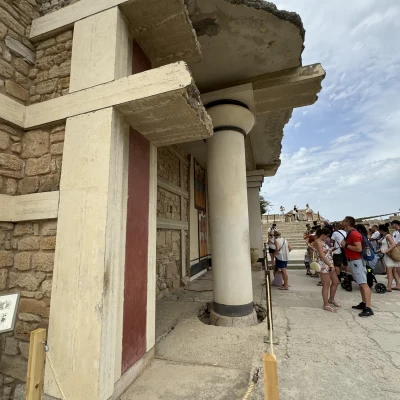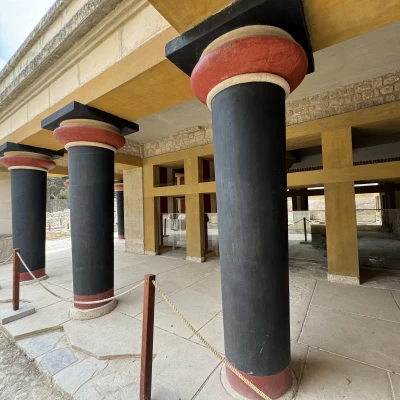Palace of Knossos
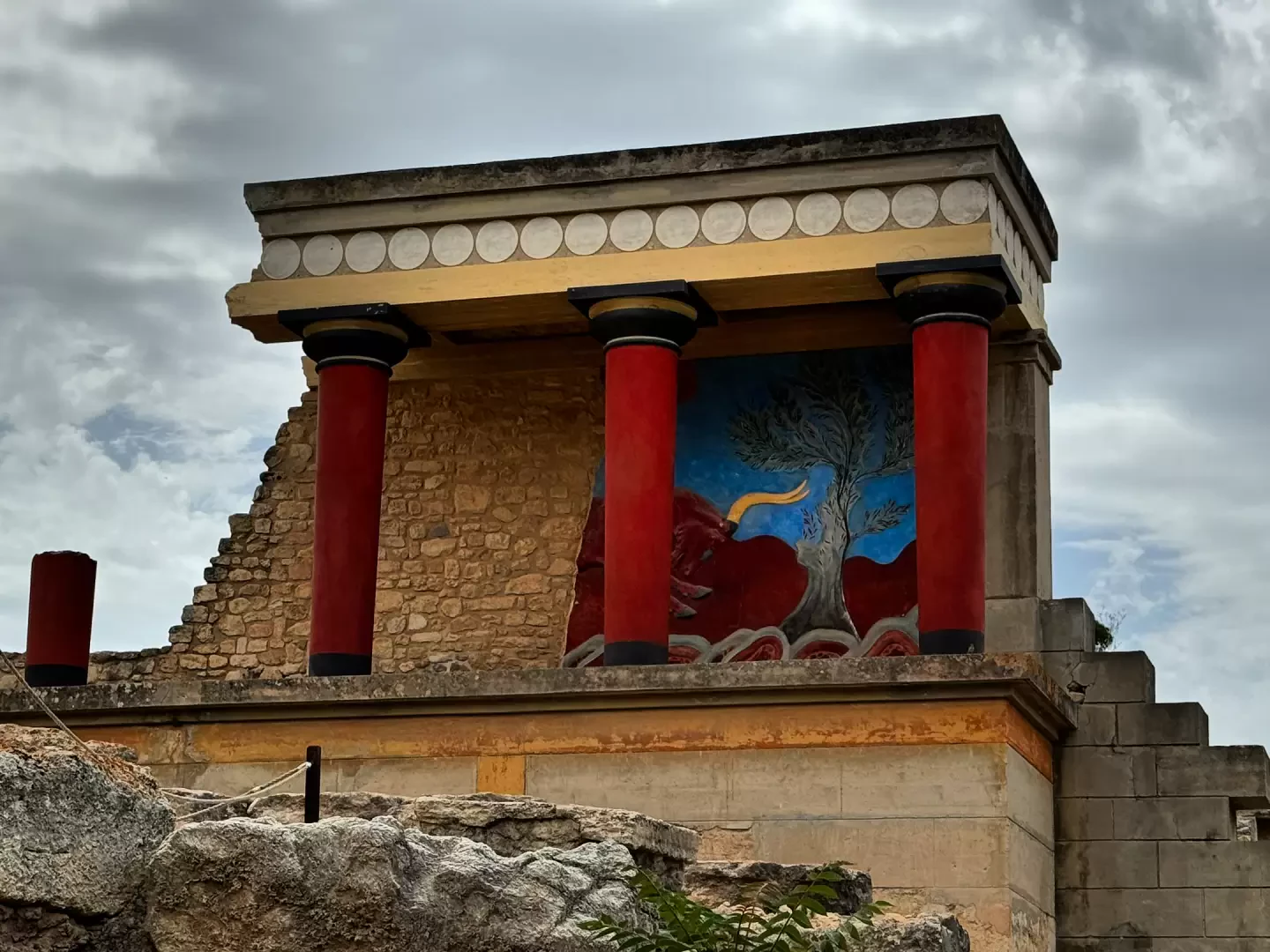
Introduction
The Palace of Knossos is one of the most important and impressive archaeological sites of the ancient Minoan civilisation, located on the island of Crete near the modern city of Heraklion. Built around 1900 B.C. and later enlarged and rebuilt after an earthquake in 1700 B.C., the palace served as the political, religious and cultural centre of Minoan society.
Characterised by a labyrinth of rooms, courtyards, storerooms and staircases, the Palace of Knossos is also famous for the legend of the Minotaur and the labyrinth built by Daedalus. Archaeological excavations, begun in 1900 by Sir Arthur Evans, have revealed vibrant frescoes, elaborate drainage systems and sophisticated architecture reflecting the prosperity and advanced social organisation of the Minoans. The Palace of Knossos offers a fascinating insight into one of the earliest and most advanced civilisations of the Mediterranean Bronze Age.
Description
History of the Palace of Knossos
The Palace of Knossos, located on the island of Crete, is one of the most significant archaeological sites of the Minoan civilisation. Its history dates back to around 2000 BC, during the Bronze Age, and the palace was the political, cultural and religious centre of Minoan society.
#### Main Periods of the Palace's History:
1. **Old Palace (2000 - 1700 BC):**
- Built around 2000 BC, the first palace was destroyed by an earthquake around 1700 BC.
- It served as an administrative and religious centre, with residential areas, warehouses and workshops.
2. **New Palace (1700 - 1450 BC):**
- Rebuilt on a larger and more elaborate scale after the earthquake.
- This period represents the zenith of Minoan civilisation, with a complex administrative structure and lively commercial activity.
- Destroyed probably by a combination of natural disasters and invasions, including the eruption of the volcano at Thera (Santorini).
3. **Decline and Abandonment (1450 - 1100 BC):**
- After 1450 BC, the Minoan civilisation began to decline, and the palace was partially used by the Mycenaeans, who renovated it.
- Finally, around 1100 BC, the site was finally abandoned.
### Architecture of the Palace of Knossos
The Palace of Knossos is known for its complex and advanced architecture, reflecting the social organisation and technological progress of the Minoans.
#### Main Architectural Features:
1. **Labyrinthine Floor Plan:**
- The palace covered an area of approximately 20,000 square metres, with an intricate system of corridors, rooms, storerooms and courtyards.
- The labyrinthine layout inspired the myth of the Minotaur and the labyrinth built by Daedalus.
2. **Construction Materials:**
- Built with a combination of stone, mud bricks and wood, the palace had strong stone foundations and thick walls for seismic stability.
- The use of wood was widespread to reinforce walls and floors.
3. **Main Structures:**
- **Central Courtyard:** Heart of the palace, used for religious ceremonies and public activities.
- **Magazines:** Rooms for storing oil, grain, wine and other goods, with large amphorae and ventilation systems.
- **Royal Apartments:** Residential rooms decorated with vivid frescoes, such as the "Queen's Throne" and the "King's Throne".
- **Theatre:** Small theatre used for public performances and ceremonies.
- **Sanctuary:** Sacred area for religious rituals, with altars and sacred symbols.
4. **Technological Systems:**
- **Water System:** Advanced drainage and water supply system, with terracotta pipes and baths with running water.
- **Ventilation and Lighting:** Use of skylights and windows for natural light and ventilation.
5. **Decoration and Frescoes:**
- Walls decorated with vivid frescoes depicting scenes of everyday life, nature, religious ceremonies and sporting activities such as "bull jumping".
- Minoan art is known for its vividness, realism and use of bright colours.
The Palace of Knossos represents a masterpiece of Minoan engineering and art, offering a window into the life and culture of one of the most advanced civilisations of antiquity. Its architectural complexity and the artefacts found there offer valuable insights into Minoan society, making it one of the most fascinating and studied archaeological sites in the Mediterranean.
Information
### Useful Information for Visiting the Palace of Knossos
#### Opening Hours:
- **Summer (1 April - 31 October):** 08:00 - 20:00
- **Winter (1 November - 31 March):** 08:00 - 17:00
- **Closed:** 1 January, 25 March, 1 May, Orthodox Easter, 25 and 26 December
#### Tickets:
- **Full:**Approximately €15 for adults
- **Reduced:**Approximately €8 for students and seniors
- **Free Admission:**Under 18, EU students, disabled with accompanying person
- **Combined Ticket:**Available for the Palace of Knossos and the Archaeological Museum of Heraklion, convenient for those wishing to visit both sites.
#### Getting There:
- **By Car:** The site is located about 5 km south of Heraklion and has its own car park.
- **By Bus:** Local buses run regularly from the centre of Heraklion and take about 20 minutes.
- **By Taxi:** Easy to find in the centre of Heraklion, with the journey taking about 15 minutes.
#### Guided Tours:
- Available at the entrance to the site. Professional guides offer historical and archaeological insights.
- Private tours can be booked in advance through local tourist agencies.
#### Services:
- **Information Centre:** At the entrance, with maps and brochures.
- **Cafeteria:** Snacks and drinks available.
- **Souvenir Shop:** Items related to Minoan culture and the history of Crete.
- **Public Toilets:** Located near the entrance and at various points around the site.
#### Visiting Tips:
- **Clothing:** Wear comfortable shoes and light clothing. Bring a hat and sunscreen during the summer months.
- **Water:** Bring a bottle of water, especially on hot days.
- **Visit Time:** Plan to spend at least 2-3 hours exploring the site at leisure.
- **Best Time to Visit:** Early morning or late afternoon to avoid the hottest hours and crowds.
#### Accessibility:
- The site has limited access for people with reduced mobility, but there are areas that can be visited with the assistance of site staff.
Photography:
- Photography is permitted, but without the use of flash within covered areas or the museums.
Visiting the Palace of Knossos offers a fascinating immersion into the ancient history of Crete, allowing you to explore one of the oldest and most advanced civilisations in the Mediterranean.

